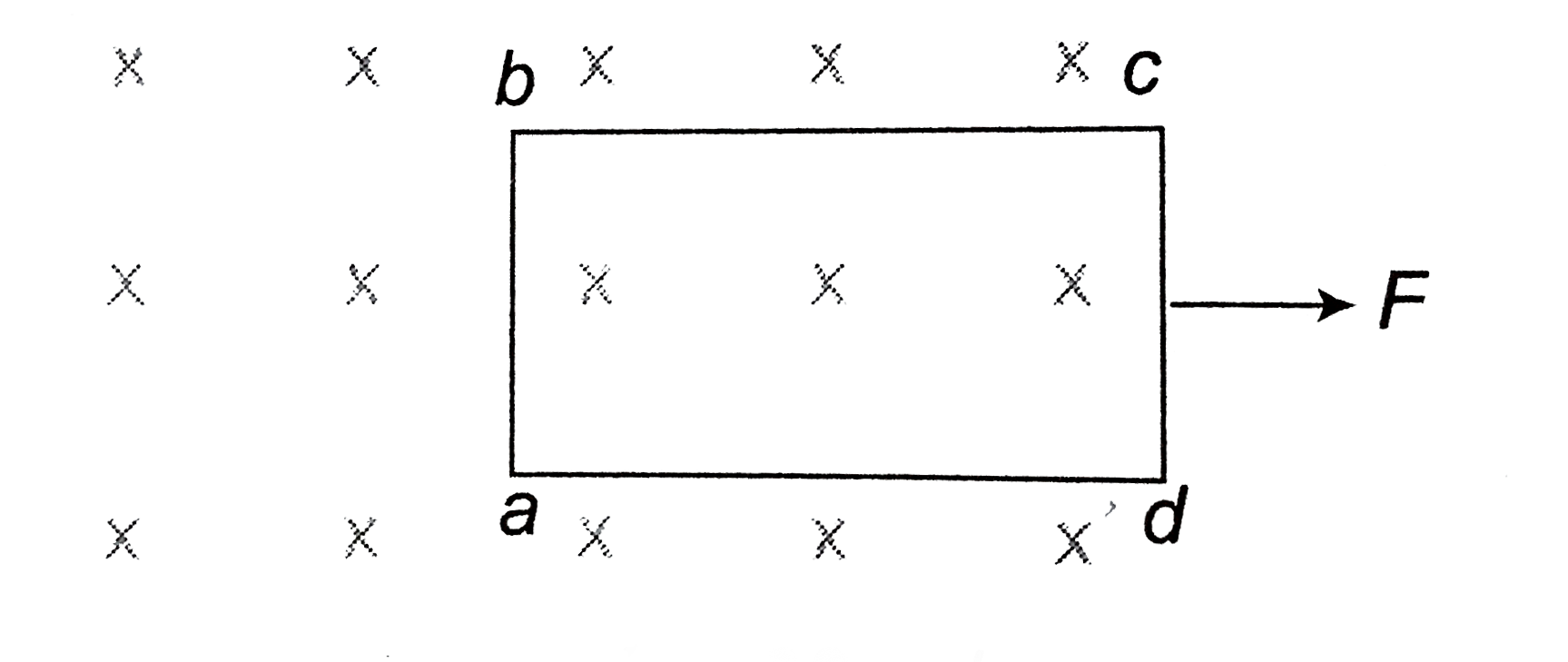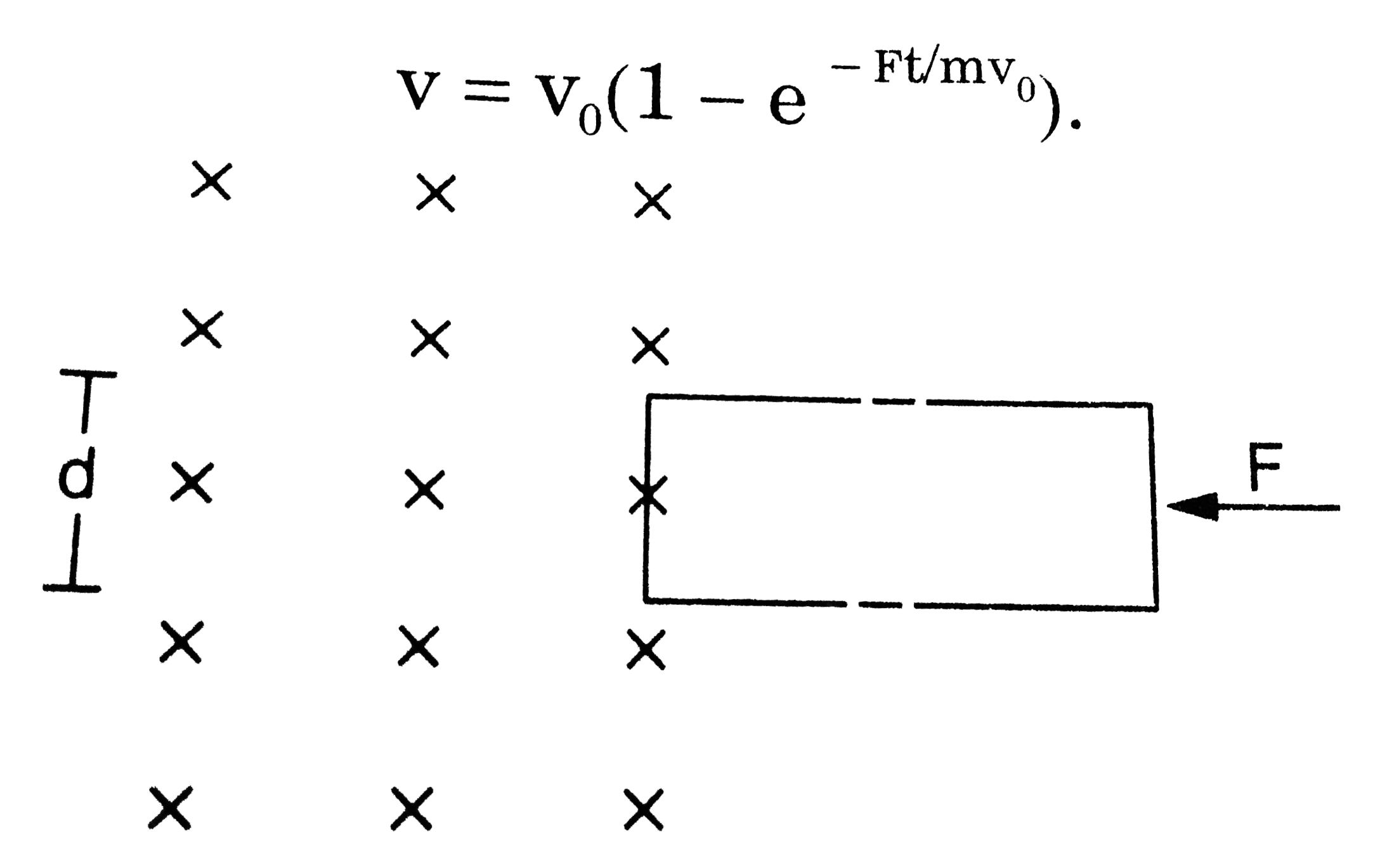A rectanguar frame of wire abcd has dimensions 32cm X 8.0 cm and a total resistance of 2.0 Ω. It is pulled out of a magentic field B = 0.020 T by applying a force of 3.2X10−5 N . It is found that the frame moves with constant speed. Find (a) this constant speed, (b) the emf induced in the loop, (c) the potential difference between the points c and d.
 Solution in Tamil
Solution in Tamil
Here R=2.0Ω,
B=0.020T,
l=32cm=0.32m,
b=8cm=0.08m
(a)F=i/B=3.2×10−5N
⇒B2l2vr=3.2×10−5
⇒(0.020)2×(0.08)2×v2=3.2×10−5
⇒v=32×10−56.4×10−3×4×10−40
=25m/s.
(c)Resistanceofpartadcd=2×0.720.8=1.8Ω.
Vab=iR=Blv2×1.82
=0.036V=3.6×10−2V
(d)Resistanceofcd
=2×0.80.8=0.2Ω
V=iR=2×0.08×25×0.22
=4×10−3V.
Topper's Solved these Questions
- ELECTROMAGNETIC INDUCTIONBOOK - HC VERMACHAPTER - ELECTROMAGNETIC INDUCTIONEXERCISE - Objective 2
10 Videos
- ELECTRIC FIELD AND POTENTIALBOOK - HC VERMACHAPTER - ELECTRIC FIELD AND POTENTIALEXERCISE - Exercises
75 Videos
- ELECTROMAGNETIC WAVESBOOK - HC VERMACHAPTER - ELECTROMAGNETIC WAVESEXERCISE - Exercise
9 Videos
Similar Questions
A bar magnet is moved along the axis of a copper ring placed far away from the magnet. Looking from the side of the magnet, an anticlockwise current is found to be induced in the ring. Which of the following may be true?
View SolutionFind the dimensional formula of ε0 .
View SolutionShow that the dimensions of the displacement current (ε0dΦEdt) are that of an electric current.
View SolutionAssertion: A frame moving in a circle with constant speed can never be an inertial frame. Reason: It has a constant acceleration.
View SolutionA constant current I flows through a long straight wire as shown in figure. A square loop starts moving towards righ with as constant speed v . a Find induced emf produced i the loop as a function x b. If total resistance of the loop is R , then find induced current in the loop,
View SolutionIn Fig. there is a frame consisting of two square loops having resistors and inductors as shown. This frame is placed in a uniform but time-varying magnetic field in such a way that one of the loops is placed in crossed magentic field and the other is placed in dot magnetic field. Both magnetic fields are perpendicular to the planes of the loops. If the magnetic field is given by B = (20 + 10 t) Wb m^(-2) in both regions [l = 20 cm, b = 10 cm , and R = 10 Omega , L = 10 H ), The direction in induced current in the bigger loop will be
View SolutionA rectangular frame of wire abcd has dimensions 1m×0.5m and a total resistance of 30Ω . It is pulled out of a magnetic field B=2T by applying a force of 1N . It is found that the frame moves with constant speed.
(i) The constant speed is 30m/sec
(ii) The emf induced in loop is 30 volt
(iii) The p.d. between a and b is 25V
(iv) The p.d. between c and d is 5V .

View SolutionABC is a triangular frame made of a conducting wire and is right angled at B. Its side BC is vertical and AB is horizontal. The frame is placed in a uniform magnetic field B in vertically upward direction. The frame is rotated about its side BC with constant angular speed ω. Resistance of the entire frame is R. Neglect gravity. Length AB=L,BC=2L.
(a) Find the torque needed to keep the frame rotating with constant angular speed.
(b) Find the potential difference between points A and C.
View SolutionA square frame of wire abcd of side 1m has a total resistance of 4Ω.It is pulled out of a magnetic field B=1T by applying a force of 1N (figure).It is found that the frame moves with constant speed.Find (a)this constant speed. (b)the emf induced in the loop, (c) the potential difference between the points a and b and (d)the potential difference between the points c and d.

View SolutionA square frame of side 10 cm and a long straight wire carrying current 1 A are in the plane of the paper. Starting from close to the wire, the frame moves towards the right with a constant speed of 10ms−1 (sec figure). The e.m.f induced at the time the left arm of the frame is at x = 10 cm from the wire is

View SolutionShown a square loop of side 5 cm beign moved towards right at a constant speed of 1 cm/s. the front edge enters the 20 cm wide magnetic field at t=0. Find the emf induced in the loop at (a)t=2s,(b)t=10s,(c)t=22s,(d)t=30s.

View SolutionThe rectangualr wire- frame, shown in has a width d, mass m, resistance R and a large length. A uniform magnetic field B exists to the left of the frame. A constant force F starts pushing the frame into the magnetic field at t =0. (a) Find the acceleration of the frame when its speed has increased to v. (b) Show that after some time the frame will move with a constant velocity till the whole frame enters into the magnetic field. find this velocity v0. (c) show that the velocity at tiem t is given by v=v0(1−e−Ftmv0.

View SolutionAssertion: A frame moving in a circle with constant speed can never be an inertial frame. Reason: It has a constant acceleration.
View SolutionA constant current I flows through a long straight wire as shown in figure. A square loop starts moving towards righ with as constant speed v . a Find induced emf produced i the loop as a function x b. If total resistance of the loop is R , then find induced current in the loop,
View SolutionIn Fig. there is a frame consisting of two square loops having resistors and inductors as shown. This frame is placed in a uniform but time-varying magnetic field in such a way that one of the loops is placed in crossed magentic field and the other is placed in dot magnetic field. Both magnetic fields are perpendicular to the planes of the loops. If the magnetic field is given by B = (20 + 10 t) Wb m^(-2) in both regions [l = 20 cm, b = 10 cm , and R = 10 Omega , L = 10 H ), The direction in induced current in the bigger loop will be
View SolutionIn Fig. there is a frame consisting of two square loops having resistors and inductors as shown. This frame is placed in a uniform but time-varying magnetic field in such a way that one of the loops is placed in crossed magentic field and the other is placed in dot magnetic field. Both magnetic fields are perpendicular to the planes of the loops.
If the magnetic field is given by B=(20+10t)Wbm−2 in both regions [l=20cm,b=10cm, and R=10Ω, L=10H),

The current in the frame as a funtion of time will be
View Solution
